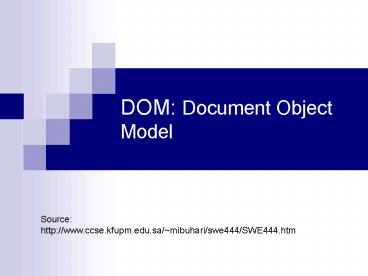DOM: Document Object Model - PowerPoint PPT Presentation
1 / 23
Title:
DOM: Document Object Model
Description:
var xmlDoc = new ActiveXObject('Microsoft.XMLDOM') VBScript: ... var link = document.createElement('a'); link.setAttribute('href', 'mypage.htm'); 16 /23 ... – PowerPoint PPT presentation
Number of Views:2487
Avg rating:3.0/5.0
Title: DOM: Document Object Model
1
DOM Document Object Model
Source http//www.ccse.kfupm.edu.sa/mibuhari/swe
444/SWE444.htm
2
The XML Alphabet Soup
?
?
?
?
?
?
?
3
The XML Alphabet Soup
?
4
The XML Alphabet Soup
5
SAX and DOM
- SAX and DOM are standards for XML parsers -
program APIs to read and interpret XML files - DOM is a W3C standard
- SAX is an ad-hoc (but very popular) standard
- There are various implementations available
- Java implementations are provided in JAXP (Java
API for XML Processing) - JAXP is included as a package in Java 1.4
- JAXP is available separately for Java 1.3
- Unlike many XML technologies, SAX and DOM are
relatively easy
6
Difference between SAX and DOM
- DOM reads the entire XML document into memory and
stores it as a tree data structure - SAX reads the XML document and sends an event for
each element that it encounters - Consequences
- DOM provides random access into the XML
document - SAX provides only sequential access to the XML
document - DOM is slow and requires huge amounts of memory,
so it cannot be used for large XML documents - SAX is fast and requires very little memory, so
it can be used for huge documents (or large
numbers of documents) - This makes SAX much more popular for web sites
- Some DOM implementations have methods for
changing the XML document in memory SAX
implementations do not
7
SAX Callbacks
- SAX works through callbacks you call the parser,
it calls methods that you supply
8
What is the DOM?
- The Document Object Model (DOM) provides a
standard programming interface to a wide variety
of applications. The XML DOM is designed to be
used with any programming language and any
operating system. - It is fully described in the W3C DOM
specification - http//www.w3.org/DOM/
- With the XML DOM, a programmer can create an XML
document, navigate its structure, and add,
modify, or delete its elements - DOM provides generic access to DOM-compliant
documents add, edit, delete, manipulate - DOM is language-independent
- The DOM is based on a tree view of your document.
Nodes! Nodes! Nodes! - DOM useful for CSS, HTML, XML
- DOM client-side scripting HTML DHTML
9
(No Transcript)
10
DOM components
- Document top-level view of the document, with
access to all nodes (including root element) - createElement method - creates an element node
- createAttribute method - creates an attribute
node - createComment method - creates a comment node
- getDocumentElement method - returns root element
- appendChild method - appends a child node
- getChildNodes method - returns child nodes
11
DOM components II
- Node represents a node - "A node is a reference
to an element, its attributes, or text from the
document." - cloneNode method - duplicates a node
- getNodeName method - returns the node name
- getNodeType method - returns the node's type
- getNodeValue method - returns the node's value
- getParentNode method - returns the node's
parent's name - hasChildNodes method - true if has child nodes
- insertBefore method - stuffs child in before
specified child - removeChild method - removes the child node
- replaceChild method - replaces one child with
another - setNodeValue method - sets node's value
12
DOM components III
- attribute represents an attribute node -
- getAttribute method - gets attribute!
- getTagName method - gets element's name
- removeAttribute method - deletes it
- setAttribute method - sets att's value
13
Parsing the DOM
- To read and update - create and manipulate - an
XML document, you need an XML parser. - The Microsoft XMLDOM parser features a
programming model that - Supports JavaScript, VBScript, Perl, VB, Java,
C and more - A COM component that comes with Microsoft
Internet Explorer 5.0 - Supports W3C XML 1.0 and XML DOM
- Supports DTD and validation
14
Creating an XML document object
- JavaScript
- var xmlDoc new ActiveXObject("Microsoft.XMLDOM")
- VBScript
- set xmlDoc CreateObject("Microsoft.XMLDOM")
- .asp
- set xmlDoc Server.CreateObject("Microsoft.XMLDOM
")
15
Adding in a new element
- var link document.createElement('a')
link.setAttribute('href', 'mypage.htm')
16
locating a slot in the document
- by location
- document.childNodes1.childNodes0
- Find the main document element (HTML), and find
its second child (BODY), then look for its first
child (DIV) - by ID
- document.getElementById('myDiv').appendChild(txt)
17
Hiding an element
- document.childNodes1.childNodes1.childNodes0
.style.display "none"
18
Loading an XML document object into the parser
- ltscript language"JavaScript"gt var xmlDoc new
ActiveXObject("Microsoft.XMLDOM")
xmlDoc.async"false" xmlDoc.load(note.xml")
// ....... processing the document goes
herelt/scriptgt
19
Manually loading XML into the parser
- ltscript language"JavaScript"gt // load up
variable var with some xml var text"ltnotegt"
texttext"lttogtJohnlt/togtltfromgtRobertlt/fromgt"
texttext"ltheadinggtReminderlt/headinggt"
texttext"ltbodygtDon't forget your
homework!lt/bodygt" texttext"lt/notegt" // now
create the DO var xmlDoc new
ActiveXObject("Microsoft.XMLDOM")
xmlDoc.async"false" xmlDoc.loadXML(text) //
....... process the document lt/scriptgt
20
parseError object
- document.write(xmlDoc.parseError.property)
- errorCode Returns a long integer error code
- reason Returns a string explaining the reason
for the error - line Returns a long integer representing the
line number for the error - linePos Returns a long integer representing the
line position for the error - srcText Returns a string containing the line
that caused the error - url Returns the url pointing the loaded document
- filePos Returns a long integer file position of
the error
21
Traversing nodes
- set xmlDocCreateObject("Microsoft.XMLDOM")
xmlDoc.async"false" xmlDoc.load("note.xml")
for each x in xmlDoc.documentElement.childNodes
document.write(x.nodename) document.write("
") document.write(x.text) next
22
Calling XML nodes by name
- var xmlDoc new ActiveXObject("Microsoft.XMLDOM")
xmlDoc.async"false" xmlDoc.load("note.xml")
document.write(xmlDoc.getElementsByTagName("from
").item(0).text)
23
References
- W3School DOM Tutorial
- http//www.w3schools.com/dom/default.asp
- MSXML 4.0 SDK






























